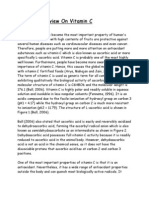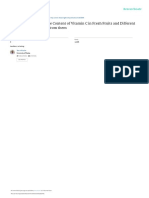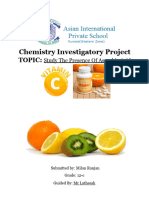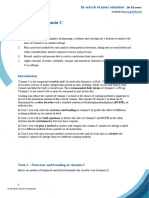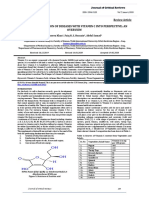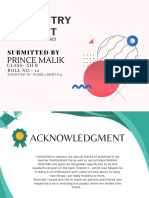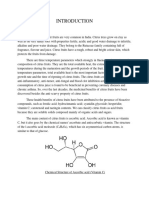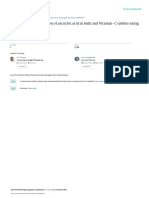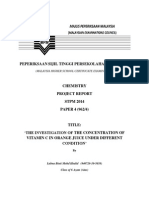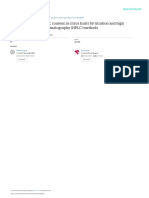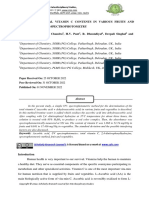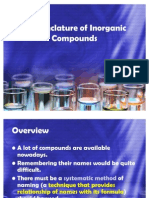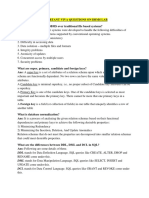Method For Preparation of Vitamin C and Method For Determination of Vitamin C in Tablets
Method For Preparation of Vitamin C and Method For Determination of Vitamin C in Tablets
Uploaded by
Ti MaCopyright:
Available Formats
Method For Preparation of Vitamin C and Method For Determination of Vitamin C in Tablets
Method For Preparation of Vitamin C and Method For Determination of Vitamin C in Tablets
Uploaded by
Ti MaOriginal Title
Copyright
Available Formats
Share this document
Did you find this document useful?
Is this content inappropriate?
Copyright:
Available Formats
Method For Preparation of Vitamin C and Method For Determination of Vitamin C in Tablets
Method For Preparation of Vitamin C and Method For Determination of Vitamin C in Tablets
Uploaded by
Ti MaCopyright:
Available Formats
See discussions, stats, and author profiles for this publication at: https://www.researchgate.
net/publication/326392053
Method for preparation of Vitamin C and method for determination of
Vitamin C in Tablets
Article · July 2018
DOI: 10.32474/SCSOAJ.2018.01.000114
CITATIONS READS
10 15,597
1 author:
Krishna Sarma Pathy
IPL LUCKNOW AISHBAGH
102 PUBLICATIONS 193 CITATIONS
SEE PROFILE
Some of the authors of this publication are also working on these related projects:
http://www.heraldopenaccess.us/fulltext/Toxicology-Current-Research/Entecavir-Patent-Evaluation-Genotoxicity.php View project
viral flu infections View project
All content following this page was uploaded by Krishna Sarma Pathy on 14 July 2018.
The user has requested enhancement of the downloaded file.
SCIFED
Publishers
Krishnasarma Pathy, SF J Chem Res, 2018, 2:1
SciFed Journal of Chemical Research
Research Article Open Access
Process for Preparation of Vitamin C and Method for Determination of
Vitamin C in Tablets
*
Krishnasarma Pathy
*
Head - QC, Qa/R&D-Ipl Research centre, Lucknow, India
Abstract
Procedure for calcium ascorbate (VITAMIN-C) includes such technological steps as reaction of ascorbic acid
on calcium carbonate in water in recent years; the determination of vitamin C has become an important subject in the field
of biochemistry and commercial foods. This is because vitamin C plays an important role in maintaining human health.
Due to the importance of vitamin C in human beings, the quantitative analysis of vitamin C has gained a significant
increase in several areas of analytical chemistry such as pharmaceutical and food applications there are numerous
methods for the determination of vitamin C in a variety of natural samples, biological fluids and pharmaceutical
formulations. The preparation method and methods for the determination of vitamin C are spectrophotometric
methods and non-spectrophotometric methods. For non-spectrophotometric methods are such as high-performance
liquid chromatography (HPLC), titration, enzymatic method and fluorometry. Direct spectrophotometry also has been
applied to determine the vitamin C content in soft drinks, fruit juices, and cordials after correction for background
absorption in the UV region.
Introduction The synthesis of ascorbic acid was achieved by
Ascorbic acid (vitamin C) is a water-soluble Reichstein in 1933, followed by industrial production of
vitamin. It occurs as a white or slightly yellow crystal or ascorbic acid two years later by Roche. Today, vitamin
powder with a acidic taste. It is an antiscorbutic product C identical to that occurring in nature is produced on a
[1-4]. On exposure to light, it gradually darkens. In the very large industrial scale. The ultimate raw material for
dry state, it is reasonably stable in air, but in solution it the production of vitamin C (ascorbic acid) is corn or
rapidly oxidizes. Ascorbic acid (vitamin c) is freely wheat. This is converted via starch to glucose by specialist
soluble in water; sparingly soluble in alcohol; insoluble in companies, and then to sorbitol. We produce the pure final
chloroform, in ether, and in benzene. The chemical name products from sorbitol in a series of biotechnical, chemical
of ascorbic aci Veaseyd (vitamin c) is L-ascorbic acid processing and purification steps [2].
(vitamin c) . The empirical formula is C6H8O6, and the
molecular weight is 176.13.
*
Corresponding author: Krishnasarma Pathy, Head - QC, Qa/R&D-Ipl
Research centre, Lucknow, India. E-mail: drkrishnasarmapathy@yahoo.in;
Vitamin C = Ascorbic Acid Tel: 9919188895
Received June 05, 2018; Accepted June 21, 2018; Published July 04, 2018
Empirical formula: C6H8O6
Citation: Krishnasarma Pathy (2018) Process for Preparation of Vitamin C
Molecular weight: 176.1 and Method for Determination of Vitamin C in Tablets. SF J Chem Res 2:1.
Melting point: about 190°C (with decomposition) Copyright: © 2018 Krishnasarma Pathy. This is an open-access article
distributed under the terms of the Creative Commons Attribution License,
which permits unrestricted use, distribution, and reproduction in any
Appearance: white to slightly yellowish crystalline medium, provided the original author and source are credited.
powder, practically odorless, with a strong acidic taste.
SF J Chem Res Volume 2 · Issue 1 · 1000007
ISSN:XXXX-XXXX SFJCR, an open access journal page 1 of 17
Citation: Krishnasarma Pathy (2018) Process for Preparation of Vitamin C and Method for Determination of Vitamin C in Tablets. SF J Chem Res 2:1.
The water-soluble vitamin C is probably the most acid. Vitamin C is probably one of the most highly well
well-known vitamin. Even before its discovery in 1932, known. Furthermore, people have become more aware to
physicians recognized that there must be a compound the importance of vitamin C. Hence, this causes the global
in citrus fruits preventing scurvy, a disease that killed market flooded with vitamin C fortified foods. The term
as many as two million sailors between 1500 and 1800. of vitamin C is used as generic term for all compounds
Later researchers, discovered that man, other primates and exhibiting qualitatively the biological activity of ascorbic
the guinea pig depend on external sources to cover their acid. The molecular structure of vitamin C is C6H8O6 and
vitamin C requirements. Most other animals are able to the molecular weight is 176.1. Vitamin in foods: Analysis
synthesize vitamin C from glucose and galactose in their Bioavailability and Stability. United States of America:
bodies. CRC Press Taylor and Francis Group. Vitamin C is highly
Nowadays, health has become the most important polar and readily soluble in aqueous solution and insoluble
property of human’s life. Commonly, diets with high in less nonpolar solvents. It is an acidic compound due to
contents of fruits are protective against several human the facile ionization of hydroxyl group on carbon 3 (pK1
diseases such as cardiovascular diseases and even cancer. = 4.17) while the hydroxyl group on carbon 2 is much
Therefore, people are putting more and more attention on more resistant to ionization (pK2 = 11.79). The structure
antioxidant substances such as vitamin C which is also of L-ascorbic acid is shown in Figure 1.
known as ascorbic acid or more specifically L-ascorbic
Figure 1: Schematic Diagram of the rFIA-CL Manifold used in this Study for the Determination of Ascorbic Acid
Ball also stated that ascorbic acid is easily and vitamin E. It is also found to be a strong antioxidant as
reversibly oxidized to dehydroascorbic acid, forming it helps to neutralize harmful free radicals. Iodometric
the ascorbyl radical anion which is also known as Determination of Ascorbic Acid(Vitamin C) in Citrus
semidehydoascorbate as an intermediate as shown in Fruits. Research Journal of Agriculture and Biological
Figure 2. Dehydoascorbic acid possesses full vitamin C Sciences.
activity because it is readily reduced to ascorbic acid in the Vitamin C is an almost odorless white or pale
animal body. However, dehydoascorbic acid is not an acid yellow crystalline powder with a pleasant sharp taste and
in the chemical sense, as it does not have the dissociable melting point of about 190 and deg;C. It is not a carboxylic
protons that ascorbic acid has at carbon 2 and carbon 3 acid but a lactone and ease of oxidation to the presence of
positions. an enediol grouping [5]. Vitamin C is highly susceptible
One of the most important properties of vitamin C to oxidation, especially when catalyzed by metal ions
is that it is an antioxidant. Nevertheless, it has a wide range such as copper(II) ion and iron(III) ion. The functions
of antioxidant properties outside the body and can quench and activities of vitamin C are based on its properties as a
most biologically active radicals. It scavenges superoxide, reversible biological reductant. Image 1
nitroxide, hydroxide, hydrogen peroxide and will reduce
SF J Chem Res Volume 2 · Issue 1 · 1000007
ISSN:XXXX-XXXX SFJCR, an open access journal page 2 of 17
Citation: Krishnasarma Pathy (2018) Process for Preparation of Vitamin C and Method for Determination of Vitamin C in Tablets. SF J Chem Res 2:1.
Food Chemistry. In the food industry, vitamin C is used
as food additive. Ultraviolet Treatment of Orange Juice.
Journal of Innovative Food Science and Engineering
Technologies. It preserves and protects food from any
colour changes and act as an important component of
our nutrition as well. Vitamin C helps to prevent the
degradation of soft drinks and juice which helps to retain
their flavors. Hence, it increases the quality of food and
nutritional value as well. Degradation of Vitamin C in
Vitamin C participates for the growth and Citrus Juice Concentrates During Storage. Journal of Food
repair of tissues in all parts of the body. Flow injection Engineering.
spectrophotometric determination of L-ascorbic acid Degradation of vitamin C undergoes both
in biological matters. Journal of Pharmaceutical and anaerobic and aerobic pathways. Qxidation of vitamin C
Biomedical Analysis. 29, Vitamin C is a natural antioxidant in aerobic pathway occurs mainly during the processing of
that mostly found in fruits and vegetables. The main food whereas anaerobic degradation of vitamin C mainly
sources of vitamin C are citrus fruits, strawberries, peppers, during storage. Hydroxymethylfurfural (HMF) is one of the
tomatoes, cabbage, and spinach. Vitamin C [6, 7] plays decomposition products of vitamin C and acts as precursor
crucial roles in electron transport, hydroxylation reactions of brown pigments. Vitamin C degradation in packaged
and oxidative catabolism of aromatic compounds in animal fruit juices depends mainly on storage temperature, pH,
metabolism. Determination of Vitamin C (Ascorbic Acid) dissolved oxygen level, residual hydrogen peroxide, H2O2
Using High Performance Liquid Chromatography Coupled left after the sterilization of packaging material and trace
with Electrochemical Detection. Sensor metal ions.
Vitamin C can help to prevent and treat common Consequently, studies on vitamin C content in
cold, mental illness, infertility, scurvy, cancer and acquired foods are important in relation to the control of nutritional
immune deficiency syndrome (AIDS). Fluorimetric labels, the update of food databases and the establishment
Determination of Ascorbic Acid in Vitamin C Tablets of dietary reference intakes [8, 9]. Orange juice is
Using Methylene Blue. Chem. Pharm. Bull. It is reported probably the most globally accepted fruit juice and it is
to lower cancer risk and also said to have important recognized worldwide as a good source of ascorbic acid.
interactions with other vitamins. For example, excessive Characteristic of Citrus Fruits in Relation to Granulation.
intake of vitamin A is less toxic to the body when vitamin Scientia Horticulturae. In addition, there are many
C [5] is readily available. Iodometric Determination of analytical methods used to determine the concentration
Ascorbic Acid(Vitamin C) in Citrus Fruits. Research of vitamin C in the pharmaceutical samples which are
Journal of Agriculture and Biological Sciences. Due to colorimetric method, titration, enzymatic method, flow
the great importance of vitamin C in human beings, the injection analysis (FIA) and high- performance liquid
quantitative analysis of vitamin C has gained increased chromatography (HPLC). Colorimetric Determination
significance in several areas of analytical chemistry such of Ascorbic Acid in Pharmaceutical Preparations and
as pharmaceutical and food applications. Biological Samples. Microchim. Acta. Reflectometer is an
Vitamin C is also used as an index of the nutrient instrument that can used to analyze many different types
quality for fruit and vegetable products. This is because it of test which include ascorbic acid test that is concerned in
is much more sensitive to various modes of degradation this project. It provides a simple and rapid determination
in food processing and subsequent storage. Effects of of vitamin C content in many pharmaceuticals product.
hydrogen peroxide on the stability of ascorbic acid during
storage in various fruit juices. Food Chemistry. It is well Procedure for Calcium Ascorbate
known that vitamin C is easily oxidized to dehydroascorbic Process
acid in alkaline solutions, while it is relatively stable in 1. In 500.0 ml RBF fitted with thermometer pocket and
acidic solution. Vitamin C of fruit juices is readily oxidized stirrer.
and lost during staying of the juices. Ascorbic acid content 2. Take 200.0 ml DM water at 25-30°C.
of commercial fruit juices and its rate of loss upon storage. 3. Charge 30.0 gm CaCO3 at 25-30°C.
SF J Chem Res Volume 2 · Issue 1 · 1000007
ISSN:XXXX-XXXX SFJCR, an open access journal page 3 of 17
Citation: Krishnasarma Pathy (2018) Process for Preparation of Vitamin C and Method for Determination of Vitamin C in Tablets. SF J Chem Res 2:1.
4. Charge 0.5 ml TGA (Thioglycolic acid) 9. Collect filtrate
5. Maintain and stir for 1.0 hr at 25-30°C. 10. In another 1.0 lit. RBF fitted with thermometer pocket
6. Filter the slurry at 25-30°C. and stirrer.
7. Suck dry and wash with 100.0 ml water. 11. Take 500.0 ml 95.0% methanol (475.0 ml methanol
8. Suck dry and unload wet cake. and 25.0 ml water).
Wt. of wet cake 42.0 gm 12. Start addition of above filtrate in 30-45 min. at 25-30°C.
13. Maintain and stir reaction mass for 30.0 min. at
Process 25-30°C.
1. In 1000.0 ml RBF fitted with thermometer pocket and 14. Cool reaction mass to 10°C in 30.0 min.
stirrer. 15. Maintain and stir reaction mass for 1.0 hr. at 10-15°C.
2. Charge 150.0 ml water at 25-30°C. 16. Filter the reaction mass at 10-15°C.
3. Charge 100.0 g Ascorbic acid at 25-30°C. 17. Suck dry and wash with 50.0 ml methanol at 25-30°C.
4. Charge 0.2 gm EDTA and 0.2 ml TGA at 25-30°C. 18. Suck dry and unload wet cake.
5. Maintain and stir reaction mass for 15.0 min. at 25-30°C. Wt. of wet cake 100-110.0 gm Dry at 40°C under vacuum
6. Charge above wet cake in 30-45 min. at 25-30°C. LOD NMT 0.1% Wt. of dry material 90.0 gm
7. Maintain and stir reaction mass for 1.0 hr. at 25-30°C.
Solution should be hazy. 2. Methods
8. Clarify the reaction mass at 25-30°C. Equipment and Apparatus 1
Equipment and Apparatus 1:
Volumetric flask 250.00 ml (± 0.01 ml)
Beaker 500.00 ml (± 0.01 ml), 500.00 ml (± 0.01 ml), 100 ml (± 0.01 ml)
Beaker 500.00 ml (± 0.01 ml), 500.00 ml (± 0.01 ml), 100 ml (± 0.01 ml)
Graduated cylinder 50.00 ml (± 0.01 ml
Erlenmeyer flask 250.00 ml (± 0.01 ml), Erlenmeyer flask 250.00 ml
Potassium iodide (KI) 15.00g (± 0.001 g)
Iodine powder 5g
Balance
Starch powder 0.25g
Distilled water
Heater Glass rod
Vitamin C tablet (ACI Limited - Nutrivit® C)
Variables and constants
Constants Temperature: 25-26 ºC (measured with electronic thermometer)
Sun light (direct sunlight damages the structure of vitamin C) Independent
Variable Unknown amount of vitamin C in solution. Dependent Variable
The amount of iodate solution used to reach the end point of reaction
between vitamin C and iodate.
3. Experimental Procedures The endpoint is production of a blue-black color
Ascorbic acid is determined by using an oxidation- which occurs as a result of the reaction of iodine with starch
reduction reaction. The solubility of iodine is increased suspension. When ascorbic acid is present, I3 is converted
with iodide and tri-iodide is occurred: to iodide and no color change is observed. However, when
all ascorbic acid was utilized, expected blue-black color
I2 (aq) + I↔ I3 – I3 – occurs due to the reaction between starch and excess tri-
then oxidizes vitamin C to dehydroascorbic acid: iodide. This titration procedure is widely accepted and
C6H8O6 + I3 + H2O → C6H6O6 + 3I- + 2H+ Vitamin C is appropriate for testing the amount of vitamin C in the
dehydroascorbic acid tablets, liquids and fruits and vegetables.
SF J Chem Res Volume 2 · Issue 1 · 1000007
ISSN:XXXX-XXXX SFJCR, an open access journal page 4 of 17
Citation: Krishnasarma Pathy (2018) Process for Preparation of Vitamin C and Method for Determination of Vitamin C in Tablets. SF J Chem Res 2:1.
1. Preparation of Iodine Solution were weighed and smashed to form powder and average
For preparation of 0.1 M iodine solution, 10g of value was calculated.
KI was taken in a 250 ml Volumetric flask and 35 ml of
distilled water was added followed by heating the solution; Equipment and Apparatus 2
the mixture was cooled to room temperature and 3.15 g of 334 mg of the powder tablet was taken in a 100.00
solid Iodine powder was dissolved. Similarly, to prepare ml beaker and dissolved in 100 ml distilled water. 5.
0.005M of iodine solution 2g of KI was taken in a 500 ml Standardization of the iodine solution with the vitamin
beaker and dissolving in 100 ml of distilled water and 1.3 C standard solution and sample solution. The measured
g of iodine powder was stirred with small quantity of water volume of 20ml of both standard and sample was taken
and qs (quantum satis) to 1 liter. from each solution and equilibrated with 150 ml distilled
water separately into distinct two Erlenmeyer flask 250.00
2. Preparation of Starch Solution ml and titrant containing iodine solution was run against
Addition of 0.25 g of starch powder in 50ml warm analyte containing either sample or standard; 5-6 drops
distilled water, As the starch is insoluble in cold water and of prepared starch solution were added to the analyte and
needs to be boiled to stay in solution. titration was started. The burette level for each analyte for
distinctive experiment was noted as mentioned below:
3. Preparation of Vitamin C Standard Solution For standard solution the volume of iodine solution
25mg Ascorbic acid was taken in a 100.00 ml required for complete reaction = 45 ml Equally, for
beaker and dissolved in 100 ml distilled water. Sample solution the volume of iodine solution required =
49 ml The endpoint was noted when analyte appears blue
4. Preparation of Vitamin C Sample Solution in color.
From the strip of Vitamin C random two tablets
Equipment and Apparatus 2:
Weight of two tablets = 1.67g
Average = 1.67/2 = 835 mg
250 mg Ascorbic acid tablet has equivalent
weight of = 835 mg
100mg Ascorbic acid tablet has equivalent
weight of = 167*2 mg = 334 mg
4. Calculation 5. Result
For sample solution In the beginning of the Therefore, a 250 mg tablet of ascorbic acid from
experiment 20 ml of sample was taken from 100 ml of the ACI LIMITED (Nutrivit® C) contain = 2.5 × 91.54
prepared solution containing 100 mg of Ascorbic acid. As = 228.85 mg Amount of Ascorbic acid in ACI LIMITED
49 ml of iodine is required for the color change containing (Nutrivit® C) is 8.46% less than the claimed value. %
20 ml ascorbic acid solution, the dilution was done 5 times
to that of the solution. Flow-Injection Analysis (FIA)
Hence, the final volume of the iodine solution = In FIA, there is no air segmentation and it is not
49× 5 = 245 ml necessary for a state of chemical equilibrium to be reached.
Mole iodine = Mass Ascorbic acid × 1 mole 176. 12𝑔 𝑜𝑓 The sample is introduced into a carrier stream as a discrete
𝑎𝑠𝑐𝑜𝑟𝑏𝑖𝑐 𝑎𝑐𝑖𝑑 × 1000𝑚𝑙 𝑣𝑜𝑙𝑢𝑚𝑒 𝑜𝑓 𝑖𝑜𝑑𝑖𝑛𝑒 M iodine = plug. The presence of a sample-carrier interface allows
0.1g × 1/176.12 × 1000 245 𝑚𝑙 = 0.00231 mol diffusion-controlled dispersion of the sample as it is swept
For standard solution Mass Ascorbic acid = through narrow-bore tubing to create a concentration
Mole iodine × Volume of iodine × 176.12 = 0.00231 × gradient. The flow-through detector monitors the change
45 × 176.12 = 91.54 mg Initially, the amount of Ascorbic in concentration of the reaction product, which is displayed
acid was taken for 100mg and therefore for total amount as a well-defined peak.
of ascorbic acid i.e. 250 mg the ratio stands out to be 2.5 Flow-injection analysis permits a simple, rapid
(250/100). and sensitive method for the determination of vitamin
SF J Chem Res Volume 2 · Issue 1 · 1000007
ISSN:XXXX-XXXX SFJCR, an open access journal page 5 of 17
Citation: Krishnasarma Pathy (2018) Process for Preparation of Vitamin C and Method for Determination of Vitamin C in Tablets. SF J Chem Res 2:1.
C where its systems allow faster sampling rates and pharmaceuticals by flow injection analysis using brown
consumed fewer reagents compared with segmented- mono 1-10-Phenanthroline-Iron(III) complex as oxidant.
flow analysis. Memon, Dahot and Ansari had proposed Medical Journal of Islamic Academy of Sciences.
a method by using mono 1, 10-phenanthroline-iron(III) This method can be improved within certain limits
complex as oxidant. This experiment was based on its by increasing the volume of the injected sample in flow
reducing reaction on mono(1-10-Phenanthroline)-iron(III) injection analysis. The sensitivity is increased two fold with
to tris(1,10-Phenanthroline)-iron(II) (ferroin) and the the increase of sample volume. As conclusion, since the
absorbance of ferroin was monitored at 510nm through time required for sample preparation is short and reagent
spectrophotometer equipped with a flow through cell. consumption is low, hence the method is highly economical
In this analysis single channel manifold is used as and is suitable to use on routine basis for determination of
shown in Figure 2. The reagent stream is pumped at the ascorbic acid in pharmaceutical preparations.
flow rate 1.1mL/min via a peristaltic pump equipped with
PVC pump tubing. The vitamin C sample is introduced into Ultraviolet (UV) Spectrophotometry
the reagent stream via a rotary teflon valve. A calibration Direct ultraviolet spectrophotometry is a fast,
curve for vitamin C in the range 0-50ppm was plotted from simple and reliable method for the determination of
the results obtained by Memon, Memon, Dahot and Ansari vitamin C. This method can be done through alkaline
which are shown in Figure 2. treatment and the maximum absorption of vitamin C falls
Figure 2: Reagent Concentration (%) at 243nm at pH2. The absorption of UV light by the sample
matrix was the major problem in this method. Therefore,
alkaline treatment method was found to be used as
background correction in blank. This is because more than
95% of vitamin C will be destroyed in 10 minutes after
alkaline treatment which is in the range of pH 12 to 13.
UV spectrophotometry method was found to be applicable
for most fruits, fruit juices and soft drinks except those
that are unstable to alkaline treatment, and were deeply
colored, or contained high concentration of caffeine,
saccharin, caramel and tannic acid. Study of Direct
Figure 3:
Ultraviolet Spectrophotometry on the Determination of
Ascorbic Acid In Fruit Juices and Soft Drinks. Journal of
China Agriculture University.
To determine the total content of vitamin C in
food samples, a well-established method was investigated
by Khan, Rahman, Islam and Begum, 2006 by using the
2,4-dinitrophenyl hydrazine methods (DNPH). This is
a simplified method for the simultaneous determination
of total vitamin C employed coupling reaction of
2,4-dinitrophenyl hydrazine dye with vitamin C and
followed by spectrophotometric determination. The
spectrophotometric method involves the oxidation of
ascorbic acid to dehydroascorbic acid [4, 10] by the action
They also studied about the effect of reaction of bromine solution in the presence of acetic acid. Reaction
coil and reagent concentration. From the graph (Figure between dehydoascorbic acid and 2,4-dinitrophenyl
3), the maximum intensity was observed at 50cm hydrazine at 37 and deg;C temperature for three hours
reaction coil. While the results of the effect of reagent will form an osazone. The solution is treated with 85%
concentration obtained is shown in Figure 6 indicating that H2SO4 to produce a red color complex. The absorbance of
the maximum signal could be obtained at 35% reagent. all standards was measured at 521 nm (a wavelength range
Spectrophotometric determination of ascorbic acid in from 350 nm to 650 nm showed a maximum absorbance
SF J Chem Res Volume 2 · Issue 1 · 1000007
ISSN:XXXX-XXXX SFJCR, an open access journal page 6 of 17
Citation: Krishnasarma Pathy (2018) Process for Preparation of Vitamin C and Method for Determination of Vitamin C in Tablets. SF J Chem Res 2:1.
((ƛmax) at 521nm) by using a UV-spectrophotometer. The form osazone when react with DNPH [11-14]. Hence,
results obtained were taken to contruct a calibration curve. there is a chance of error in this method which may give
Figure 3.1 false results.
Figure 3.1: Another interference was due to the extracted
glucose which contains similar structure like vitamin C.
Therefore, some of the glucose may be extracted in the
meta-phosphoric acid during the extraction of ascorbic
acid from sample. Glucose may also cause the formation
of colored complex with DNPH and gives the false result
in the determination of vitamin C. This was proven in
Figure 4.1 where there is no absorption peak around the
interested peak at 521nm.
Figure 4.1: Calibration curve of standard vitamin C at 521 nm
Figure 4:
As conclusion, the method is simple and excellent
for the determination of total vitamin C in fruits and
vegetables.
Spectrum of DNPH Complex of Glucose Fluorometric Method
The calibration curve was constructed by plotting Fluorometric analysis has been used for ascorbic
the concentration versus the corresponding absorbance acid assay in pharmaceutical preparations, beverages,
as shown by Figure 4. The molar absorptivity, ? can be special dietary foods and even for human serum .This
obtained using Beer-Lambert plots. The reliabilty of method had been reported to have successful application
this method was justified by the calculations of the % of to a wide range of foodstuffs, including liver, milk, fresh
standard deviation and it was found to be varied within the and canned fruit, raw and cooked vegetables, and potato
range from 0.20 to 2.45%. The reliability of this method powder. Previously, fluorometric determinations of
was also confirmed from the consideration of the following vitamin C have been developed based on condensation
expected interferences. reactions of vitamin C with o-phenylenediamine and
There are a few interferences that might affect the on the oxidation with mercury (II) of vitamin C to form
results. First, the interference was due to the diketogulonic quinoxaline derivative. The reaction products of these
acid. At higher pH, destructive oxidation hydrolysis methods exhibit fluorescensce.
might occur. This results in the opening of the lactone Figure 5 shows the reaction of the dehydroascorbic
ring of the ascorbic acid and loose the vitamin activity. acid with 1,2-phenylenediamine dihydrochloride to form the
These processes are naturally occurred in fruits and some fluorescent quinoxaline derivative 3(1,2dihydroxyethyl)
amounts of diketogulonic acid are presence in the fruits. furol[3,4-b]quinoxaline-1-one. The blank can be prepared
Besides that, diketogulonic acid has keto group that might by complexing the oxidized vitamin with boric acid
SF J Chem Res Volume 2 · Issue 1 · 1000007
ISSN:XXXX-XXXX SFJCR, an open access journal page 7 of 17
Citation: Krishnasarma Pathy (2018) Process for Preparation of Vitamin C and Method for Determination of Vitamin C in Tablets. SF J Chem Res 2:1.
to prevent the formation of the quinoxaline derivative. bands at 682nm for MB and 452nm for LMB. In Figure
It is used to reveal any fluorescence due to interfering 7, the emission peak of MB at 682nm increased due to
substances. the increase of its concentration. A linear relationship
Figure 5: between MB concentration and intensity was obtained
over the concentration range of mol L-1 MB (y= 49.082x
+ 94.46,r2=0.9969). The excitation peak of MB at 664 nm
also linearly increased depending on the increase of its
concentration.
Figure 7:
Yusuf and Gurel have described a method by using
Methylene Blue (MB) for the determination of vitamin C.
This experiment was run by using a spectrofluorimeter to
record the spectra and carry out fluorescence measurements.
This method was used to determine the amount of vitamin
C in the purified materials, specifically vitamin C tablets.
MB is a member of thiazine dye group. It is widely used
in many different areas. For example, a photo sensitizer is
used to produce singlet oxygen in photodynamic therapy
for the treatment of cancer. The highly colored oxidized The studies of the effect of vitamin C on the
form of MB can be reduced to be colorless leuco form, fluorescence of MB is made to avoid any errors that might
Leuco-Methylene Blue (LMB) which is shown in Figure affect the accuracy of the results. In order to examine
6. LMB is the reduced and colorless form of methylene the effect of vitamin C on the fluorescence of MB at 664
blue. nm, mol L-1 MB solutions, each solution was added with
Figure 6: different concentration of vitamin C and were prepared
under nitrogen (N2) atmosphere. This was shown in Figure
8 where the spectra were recorded at 664nm.
Figure 8 above shows the excitation intensity of
mol L-1 without adding vitamin C was about 1000.0 and
above. The intensity was decreased by the increase of
vitamin C concentration in MB solutions.
Figure 9 shows the emission spectrum of mol L-1
MB as a function of time. Each spectrum was recorded at 1
minute intervals. The results showed that the fluorescence
was not changed with time, reflecting that the fluorescence
spectrum of MB was highly stable with time.
In the redox reaction between ascorbic acid and
MB, the ascorbic acid is oxidized to dehydroascorbic acid,
while MB was reduced to colorless LMB as shown in the
following:
The calibration curve was made based on the
According to Yusuf and Gurel, the fluorescence concentration of MB (mol L-1). The results indicate that
bands of MB were obtained at 664nm for excitation the fluorescence intensity of the system is a linear function
state and 682nm for emission peaks. This was proven by of vitamin C concentration in the range of mol L-1 and the
the other researchers who also examined the emission regression coefficient is 0.9941 as shown in Figure 10.
SF J Chem Res Volume 2 · Issue 1 · 1000007
ISSN:XXXX-XXXX SFJCR, an open access journal page 8 of 17
Citation: Krishnasarma Pathy (2018) Process for Preparation of Vitamin C and Method for Determination of Vitamin C in Tablets. SF J Chem Res 2:1.
Figure 8: Table 1 below shows the tolerance towards
different compounds that might cause interferences in this
method. These compounds are usually present in most
vitamin C tablets. The experimental results showed that
the presence of hundred-fold excess of the all contaminant
compounds and twenty-fold excess of citric acid did not
significantly influence the determination of vitamin C
using this method. Therefore, it can be concluded that
there is no major interference caused by these compounds.
So it is possible to use this method for direct determination
of vitamin C in pharmaceuticals without separating the
interfering materials.
Table 1: Tolerance towards Different Substances in the Determination
of Ascorbic Acid
Maximum Tolerable
Additive Type
Concentration Ration
Glucose, fructose, alanin, saccharose,
100
urea, acetat, benzoic acid
Citric acid 200
a) Ascorbic Acid Concentration 1.0x10 -
6
mol.l-1
Table 2: Determination of Ascorbic Acid in Pharmaceutical Preparations
Amount of Ascorbic Acid (mgg-1)
Figure 9:
Sample Proposed Method a) Reference Method
Redoxon (Roche) 205.203 ± 9.20 218.02 ± 1.14
Sandoz (Novartis) 129.87 ± 7.72 145.63 ± 2.02
Mean for Five determinations.
Table 2 lists the results obtained by the proposed
method with triiodide method. It can be clearly seen that
the results are in good agreement with the triiodide method.
Thus, the proposed method provides a simple
and sensitive fluorimetric procedure by using MB for the
determination of vitamin C. This experiment also shows
that MB could be used for fluorimetric determination of
vitamin C in vitamin C tablets although it has only slightly
Figure 10: AA Concentration x10-7 mol L-1
fluorescence property compared to LMB. Therefore,
as conclusion, it can be explained that the fluorescence
intensity of MB was more sensitive to determine vitamin
C concentration.
Stability of Vitamin C in Orange Juice
Vitamin C is very susceptible to chemical and
enzymatic oxidation during the processing, storage,
and cooking of food. The catalyzed oxidation pathway
of vitamin C degradation is the most important reaction
pathway for the loss of vitamin C in foods. Therefore,
SF J Chem Res Volume 2 · Issue 1 · 1000007
ISSN:XXXX-XXXX SFJCR, an open access journal page 9 of 17
Citation: Krishnasarma Pathy (2018) Process for Preparation of Vitamin C and Method for Determination of Vitamin C in Tablets. SF J Chem Res 2:1.
vitamin C of orange juice is readily oxidized and lost prepared which one contained vitamin E stock solution
during staying of the juice. On the other hand, there are and vitamin C stock solution while another contained only
several factors that will also affect the stability of vitamin vitamin C stock solution. The samples were analysed once
C in orange juice. The factors are such as the effect of a week for five weeks.
vitamin E, pH, and parameters which include air, heat, The results of the stability of vitamin C show that
water as well as prolonged storage and overcooking. the presence of vitamin E influenced the decay of vitamin
According to Ball, a meta-oxygen-ascorbate C. It shows that there were differences between samples
complex is formed in the presence of molecular oxygen with or without vitamin E, it can be clearly seen that the
and trace amounts of transition metal which particularly concentration of vitamin C without vitamin E fell down
are copper (II) and iron (III). This complex contains a to 1.2mg/L on the second day. However, in the presence
resonance form of a diradical that rapidly decompose to of both vitamins, the decay was also observed, but it was
give the ascorbate radical anion, the original metal ion, and lesser. The concentration of vitamin C in the orange juice
hydrogen peroxide. This radical anion will in turn reacts with vitamin E was 13mg/L in the fifth week.
with the oxygen to give dehydroascorbic acid (DHAA) As a result, it seems that vitamin E stabilized
[15]. For anaerobic pathway of vitamin C which occurs vitamin C in orange juice at a determined concentration.
in the absence of free oxygen, the degradation is caused This is because vitamin E delay the oxidation of vitamin
by the formation of diketogulconic acid. As the rate of C thus, enhances the stability of vitamin C in orange juice.
degradation is maximum at pH 3 to pH 4, therefore this The combination of vitamin C with vitamin E makes
pathway is mostly responsible for anaerobic loss of vitamin the orange juice more stable and slower the degradation
C in canned grapefruit and orange juices. of orange juice. This concluded that orange juice with
vitamin E addition is a good way to preserve the vitamin
Effect of Vitamin E on The Stability of Vitamin C C content during storage. The stability of vitamin C in
In Orange Juice different beverages. British Food Journal.
Vitamin E is a fat soluble antioxidant that has
four tocopherols and four tocotrienols. In nature, these Effect of Temperature on The Stability of Vitamin
four tocopherols and four corresponding tocotrienols are C In Orange Juice
designated as alpha-(?), beta-(?), gamma-(?) and delta-(?) Vitamin C of fruit juice is readily oxidized
according to the number and position of methyl substituent and lost depends on the conditions of storage. There
in chromonal ring. are studies about the determination of the amounts of
The vitamin E functions as a biological antioxidant vitamin C content in fruit juices under different storage
by protecting the vital phospholipids in cellular and conditions. Kabasakalis, Sipadou and Moshatou had done
subcellular membranes from peroxidative degeneration. an experiment to determine the rate loss of vitamin C
Vitamin E mostly accumulates in body which are liver with respect to time and temperature of storage. A long-
and pancreas. But unlike vitamins A and D, vitamin E is life and short-life commercial orange juice 100% without
essentially nontoxic. preservatives and fresh orange juice were used for analysis.
Nagymate and Fodor have designed a method to In this experiment, the days before the expiration date
study the effect of vitamin E on the stability of vitamin C. were recorded in Table 3. to observe the loss of vitamin
In this experiment, vitamin E stock solution was prepared C in short-life and long-life orange juice 100% as the
by dissolving ?-tocopherol in absolute ethanol. The orange expiration date was approached.
juice which contained vitamin E and vitamin C was
used as sample. The storage temperature of the vials was Table 3: Program of the Temperature conditions for sample Storage
4anddeg;C and they were covered with aluminium foil STORAGE TEMPERATURE(0C)
to prevent the effect of sunlight. Besides, two different TIME (h)
Condition n0 1 Condition n0 2
temperatures were used to examine the effect of vitamin E
0 4 4
at that temperature which half of the samples were stored at
4 8 8
20anddeg;C. On the other hand, the additive effect of these
8 4 12
vitamins was also examined but only cool samples (4 and
deg;C) were used for this experiment. Two samples were 12/72 4 8
SF J Chem Res Volume 2 · Issue 1 · 1000007
ISSN:XXXX-XXXX SFJCR, an open access journal page 10 of 17
Citation: Krishnasarma Pathy (2018) Process for Preparation of Vitamin C and Method for Determination of Vitamin C in Tablets. SF J Chem Res 2:1.
Table 3. shows the loss of vitamin C from fresh As reported, decreases of vitamin C upon storage did not
and long-life commercial orange juice 100% during a 31 correspond to increases of dehydroascorbic acid levels. In
days period, with measurements made every 1 to 3 days. fact, there was an increase of dehydoascorbic acid levels
The samples were refrigerated into containers which in aseptically packaged orange juices. This means that the
after the initial measurement remained either open or overall nutritional quality of orange juices is affected upon
with closed cap until the next measurement. Based on storage.
the results shown in table 4, the magnitude of vitamin C The loss of the vitamin C in a commercial long-
did not differ significantly between open and closed cap life orange juice 100% stored in refrigerator and non-
for both juices. The commercial orange juice lost higher refrigerated for a period of 10 days in open containers
amounts of vitamin C compared with fresh orange juice. were shown in Figure 11.
Table 4: Reaction Rate Constant (k) for Ascorbic Acid Degradation in the Presence of Hydrogen Peroxide in Various Fruit Juices during Storage
Zero-Order First-Order
Sample H2O2Concentration(ppm) Temperature
K(mgl1h1) R2 K (h-1) R2
0.5 20 1.24 0.972 0.0029 0.922
0.5 30 2.1 0.953 0.0058 0.854
Orange Juice
0.5 40 3.5 0.989 0.0131 0.885
5 40 6.62 0.957 0.0184 0.964
Figure 11:AA Concentration (mg/100g) in Natural Orange Juice Stored Under Isothermal Conditions (a) and Non- Isothermal (b) conditions
(Condition n0 1- 4h/80C and 60h/40C; Condition n02-4h/40C, 4h/120C and 64h/80C)
Table 5: Assessment of Unpasteurized Refrigerated Orange Juice Stored Under Isothermal and Non-Isothermal Conditions for 72 hours
ISOTHERMAL CONDITIONS NON-ISOTHERMAL CONDITIONS
MEANS
4C
0
8C
0
12 C
0
n0 1 N0 2
pH 3.24 ± 0.02 3.27 ± 0.02 3.30 ± 0.02 3.27 ± 0.05 3.28 ± 0.03
TSS 10.43 ± 0.36 10.55 ± 0.28 10.54 ± 0.28 10.54 ± 0.28 10.52 ± 0.26
TTA 2.20 ± 0.06 2.17 ± 0.8 2.12 ± 0.04 1.97 ± 0.09 2.02 ± 0.13
TSS/TTA 4.75 ± 0.26 4.88 ± 0.25 4.98 ± 0.15 5.36 ± 0.36 5.22 ± 0.35
SF J Chem Res Volume 2 · Issue 1 · 1000007
ISSN:XXXX-XXXX SFJCR, an open access journal page 11 of 17
Citation: Krishnasarma Pathy (2018) Process for Preparation of Vitamin C and Method for Determination of Vitamin C in Tablets. SF J Chem Res 2:1.
According to Figure 2, Table 5 non-refrigerated samples increase the degradation of vitamin C. However, raising
show higher percentage loss of vitamin C as compared to H2O2 concentration from 0.5ppm to 5ppm resulted in
refrigerated samples. This is because the dehydoascorbic a tremendous increase in degradation rates which was
acid, the oxidized form of ascorbic acid was more stable recorded in Table 6. At 0.5ppm H2O2, the antioxidant
at lower temperatures. Thus, the vitamin C, in the form substances in orange juice which was flavonols reacted with
of dehydroascorbic acid for refrigerated orange juice was H2O2, thereby preventing the autoxidation of vitamin C.
well retained than non-refrigerated orange juice. The protective mechanism of flavanols was mainly due to
chelation of metal ions and action of antioxidant. Flavanols
Effect of Hydrogen Peroxide on The Stability of function as antioxidants by donating the hydrogen ions
Orange Juice to reactive free radicals which may otherwise cause the
Hydrogen peroxide, H2O2 is the primary chemical autoxidation of vitamin C.
for sterilization of plastic packaging material used in Figure 12:
aseptic system. Aseptic packaging technology is widely
used by fruit juice industry for the production of shelf-life
stable fruit juices. A Food and Drug Administration (FDA)
regulation currently limits the residual of H2O2 to 0.5ppm,
leached into distilled water, in finished food packages
which stated in Code of Federal Regulations, 2000.
However, during the sterilization of aseptic chambers or
packaging material with H2O2, some residues will still be
left on the packaging material or vapors generated during
drying may get trapped inside the package upon sealing.
These residues will then cause the degradation of vitamin
C.
An experiment was proposed by Ozkan, Kirca and
Cemeroglu to determine the rates of vitamin C degradation
in orange juice with or without addition of H2O2 at various
storage temperatures. In this experiment, the orange juice Ozkan, Kirca and Cemeroglu also studied the
sample was thawed at room temperature and sodium degradation of vitamin C in the absence of H2O2. In this
benzoate was added to prevent spoilage. The degradation case, the activation energy, Ea was taken into account to
studies were done at H2O2 with 0.5ppm concentration at determine the stability of vitamin C in orange juice. The
20anddeg;C, 30anddeg;C and 40anddeg;C respectively. temperature dependence of the degradation of vitamin
At regular time intervals, samples were removed from the C in orange juice was compared by calculating Ea and
water bath or incubator. Then, the predetermined amounts temperature quotients (Q10) at 20anddeg; to 40anddeg;C
of diluted sodium hydroxide solution were added rapidly to from the following equation:
the samples to halt the reaction between H2O2 and vitamin These results clearly indicate that the rate of
C. The samples were then rapidly cooled by plugging into vitamin C degradation in the presence of H2O2 was
an ice water bath and held at -30anddeg;C until analyzed for slower at 30anddeg;C to 40anddeg;C than 20anddeg;C
vitamin C content. Vitamin C concentration was measured to 30anddeg;C. This indicates that at 30anddeg;C to
by using HPLC method. Qzkan, Kirca and Cemeroglu 40anddeg;C, the least effect of temperature rise on vitamin
had modified the method by blending the orange juice C degradation. The results obtained for Ea shows that
sample with metaphosphoric acid. The sample was filtered higher Ea in the presence of H2O2. This means that higher
through a membrane filter and was analyzed using HPLC energy needed for the degradation of vitamin C. Therefore,
(Shimadzu brand).Vitamin C contents of orange juice were the reaction time is slower and the degradation of vitamin
plotted for various temperatures at 0.5ppm H2O2. C also slower. As conclusion, the effect of temperature on
From Figure 12, the results show that at higher the degradation rates of vitamin C in orange juice was more
temperature, the rate of vitamin C degradation also pronounced at higher H2O2 concentrations. Therefore,
increased. The addition of 0.5ppm H2O2 did not greatly greater vitamin C losses should be expected as residual
SF J Chem Res Volume 2 · Issue 1 · 1000007
ISSN:XXXX-XXXX SFJCR, an open access journal page 12 of 17
Citation: Krishnasarma Pathy (2018) Process for Preparation of Vitamin C and Method for Determination of Vitamin C in Tablets. SF J Chem Res 2:1.
H2O2 concentration and storage temperature increase in 5.0 or below, dehydroascorbic acid was quite stable which
aseptically packaged fruit juices. decayed by less than 3% over 4 hours. This experiment
evaluated the effect of hydrogen ion concentration on
Effect pf Ph on The Stability of Vitamin C delactonization of dehyroascorbic acid over the range of
pH is a measure of acidity or basicity of a solution. pH 3.0 to pH 8.0. The possible influence of the presence
pH is one of the primary factor that would affects the of oxygen was done by equilibrating the reaction mixture
stability of vitamin C in orange juice. Hence, the pH value before and during the incubation with 100% oxygen or
of the matrix has an influence on the stability of vitamin C. with 100% nitrogen. The results indicated no change in the
According to FAO/WHO Expert Consultation on Human decay rate of dehydoascorbic acid was obvious with these
Vitamin and Mineral Requirements, Bangkok, Thailand, alterations of atmospheric conditions[16-18]. The rate of
1998, the vitamin C will decay if the pH higher than 4. dehydroascorbic acid hydrolysis markedly increases with
Vitamin C is unstable in neutral and alkaline increasing temperature but was unaffected by the presence
environments, therefore the higher the pH value and the of oxygen (Bode, Cunningham and Rose, 1990 Bode,
longer the exposure, the greater the loss of vitamin C. This M., Cunningham, L. and Rose, R. C. 1990. Spontaneous
is because the higher the pH value, the faster the oxidation Decay of Oxidized Ascorbic Acid (Dehydro-L-ascorbic
reaction of vitamin C and causes the degradation of acid) Evaluated by High-Pressure Liquid Chromatography.
vitamin C. Besides that, the increase in pH also related to Clinical Chemistry. Other researchers had proposed a
deterioration of fruit characteristic which in this literature method to determine the effect of pH on the degradation
review, orange juice is more concerned. Table 5 below of vitamin C in orange juice. The aim of their experiment
shows the pH value of the fruit juice with storage time. was by comparing the stability of vitamin C at different
Table 6: concentrations at lower pH value. An acidic sample was
Table 6: Ascorbic Acid Content (mg/100mL) at Different Storage prepared from orange juice with medium alcohol content
Times after Squeezing [11]. The original pH value of sample was later modified
by addition of concentrated phosphoric acid. After that,
NATURAAL ORANGE JUICE
different concentrations of vitamin C stock solutions were
Mean ±0 (% Retention) added and analysed for five weeks. The stability of vitamin
Time 1 2 C in different beverages. British Food Journal.
0 55.26 ± 0.22 5054 ± 0.15(100) The results showed that, for the experiment done
1 53.85 ± 0.14(97.45) ____ in original pH value of the orange juice which was pH 4.0,
3 52.40 ± 0.33(94.82) 50.36 ± 2.44(99.64) the reduction of the amount of vitamin C content decreased
5 50.76 ± 0.97(91.86) ____ with the increasing ascorbic acid concentration (p> 0.05),
6 50.00 ± 0.97(90.48) 50.33 ± 0.47(99.58) so the speed of decay was higher at lower concentrations.
24 48.20 ± 3.27(87.22) 50.22 ± 0.60(99.45)
In the case of orange juice, the highest standard deviation
of the repeated data was 3.14% and the lowest standard
In this the pH values of the orange juice were deviation was 1.48%. This indicates that the results are
higher at room temperature pH values keep increasing accurate and reproducible.
from week to week. This study concluded that, though pH When lower pH (pH 3.0) was used, the speed of
was significant for the stability of vitamin C, it was not the decay for orange juice grew with the growing vitamin C
sole factor in controlling the deterioration of vitamin C in concentration, and the highest value was at 50mg/L vitamin
orange juice with storage life. On the other hand, the loss of C concentration (p> 0.05). These results were tabulated in
vitamin C activity during oxidative degradation of vitamin Table 10. The highest standard deviation of the repeated
C occurs with the hydrolysis of the dehydroascorbic acid data was 3.42% and the lowest standard deviation was
lactone to yield 2,3-diketogulonic acid. This hydrolysis is 1.53%. By comparing the statistical data, it shows that the
favored by alkaline solution. Dehydroascorbic acid is most lower pH values increased the vitamin C content measured
stable at pH 5.5 but decrease in stability as pH increases at the end of fifth week.
which is more than pH 5.5. For example, half-time values According to Nagymate and Fodor, vitamin C
of dehydroasorbic acid hydrolysis at and deg;C were 100 had a significant decay independently from the storage
and 230 minutes at pH 7.2 and pH 6.6 respectively. At pH temperature when the pH value was more than 4.0.
SF J Chem Res Volume 2 · Issue 1 · 1000007
ISSN:XXXX-XXXX SFJCR, an open access journal page 13 of 17
Citation: Krishnasarma Pathy (2018) Process for Preparation of Vitamin C and Method for Determination of Vitamin C in Tablets. SF J Chem Res 2:1.
Nevertheless, under this pH limit, low storage temperature Experimental Procedure
will help in stabilizing this vitamin. Hence, lower pH value Determination of Vitamin C By Using Reflectometer
was preferred to prolong the shelf life of orange juice[11, (Merck)
14, 16]. As control method for ascorbic acid test, 0.02g of
ascorbic acid was diluted with 100mL of distilled water.
Materials and Methods The ascorbic acid solution should be freshly prepared.
Analysis of Vitamin C Content in Vitamin C Tablets Beside that, two additional tests were done by using the
Instrument, Materials and Chemicals same instrument but different test kits which used to test
The instrument that used in this research is Reflectometer. the glucose and hydroxymethylfurfural (HMF) test. The
The chemicals that used in this research are as below: respective strip was immersed into the sample for few
1. 1 gdm-3 of Ascorbic Acid (Sigma) seconds. The test strip was inserted into the strip adapter.
2. 0.1M Sodium Hydroxide (R and M Chemicals) At the end of reaction time, the result was read from the
3. Phenolphthalein indicator display.
4. Potassium acid phthalate (Hamburg Chemical GMBH)
The materials that used in this research are as below (refer Determination Of Vitamin C By Using Titration
to appendix 1): Method
1. Flavettes Vitamin C-Sugar-Free C Standardization Of 0.1M Sodium Hydroxide (Naoh)
2. Redoxon Orange Standard potassium acid phthalate (KHP),
3. Cebion Vitamin C KC8H4O4H solution was prepared by weighing 0.5g dried
4. Bio C Plus (Anway) KHP into an Erlenmeyer flasks and was dissolved by
adding 75mL of distilled water. The molecular weight of
Product Sample Preparation KHP is 204.23. Three drops of phenolphthalein indicator
The vitamin C tablets were crushed into powder were added into each Erlenmeyer flask. For 0.1M NaOH
by using mortar and pestle. 1 g dm-3 of each sample was standardization, KHP solution was used and titrated with
prepared by dissolving 0.1±0.05g of the samples with 0.1M NaOH until the faintest pink persists for 30 seconds.
distilled water and top up to 100 mL. The solutions were The final volume was recorded. The standardization of
thoroughly mixed. The solutions were kept away from NaOH was repeated for another two times.
direct sunlight and stopper was used to minimize the
oxidation of ascorbic acid [16]. Vitamin C Analysis: Quantitative Method
0.2g of vitamin C was weighed and then added
Reagent Solution Preparation into an Erlenmeyer flask. 50mL of distilled water was
added to dissolve the vitamin C tablet. Three drops of
Preparation of Vitamin C Standard Solution phenolphthalein indicator were added into the Erlenmeyer
A freshly prepared ascorbic acid solution was flask. A burette which contains 0.1M of NaOH solution
prepared by dissolving 0.02g of ascorbic acid and top was set up as which as shown in Figure 22. The vitamin C
up to 100mL with distilled water in a volumetric flask. solution was titrated with NaOH solution was until a pink
The solution was thoroughly mixed. The solution was color that persists for 30 seconds which was the end point.
kept away from direct sunlight and a stopper was used to The final volume was recorded. These procedures were
minimize the oxidation of ascorbic acid. repeated for another two sets of sample.
Preparation of Sodium Hydroxide Solution Results and Discussion
0.1M of sodium hydroxide solution was prepared Determination of Vitamin C by Using Reflectometer
by adding 2.0g of sodium hydroxide (NaOH) pellets and (MERCK)
was topped up to 500mL into a volumetric flask. This In this project, reflectometer and titration method
solution was mixed and was standardized using potassium were used to determine the vitamin C content in four
acid phthalate (KHP) solution. pharmaceutical products which are Flavette, Cebion, Bio
C Plus and Redoxon Orange. In reflectoquant analysis,
Reflectoquant Test Strips are inserted into the instrument
SF J Chem Res Volume 2 · Issue 1 · 1000007
ISSN:XXXX-XXXX SFJCR, an open access journal page 14 of 17
Citation: Krishnasarma Pathy (2018) Process for Preparation of Vitamin C and Method for Determination of Vitamin C in Tablets. SF J Chem Res 2:1.
(RQflex 10) which is a highly sensitive reflectrometry the product samples contain about 1.3 to 1.5 mg/L of HMF.
instrument. The combination of these two tests which are Based on the Commission Regulation, the average usage
the test strips and the reflectometer help to analyze the of HMF is 2.0mg/L and the maximum usage is 10.0mg/L
vitamin C content for a wide variety of samples in just for non-alcoholic products. HMF is a crystalline product
few seconds. Reflectometer uses a double optic system with a pleasant odor. HMF is formed in foods by thermal
which works in conjunction with a dual reaction zone on treatment during storage. High amount of HMF can cause
Reflectoquant Test Strips to allow for simultaneous double vitamin C loss, hence affecting the quality of the product.
measurements in one step. It is a portable test system Evaluation and optimization of non enzymatic browning
that is small, compact, and battery-operated for rapid, of “cajuina” during thermal treatment. Brazilian Journal of
quantitative analysis of various samples by evaluation of Chemical Engineering.
special test strips [18].
Vitamin C contents in each sample which is Determination of Vitamin C by Using Titration Method
determined using reflectometer do not have much Standardization of Sodium Hydroxide (NaOH) Solution
different compared to the label value. Tablets are labeled Using Potassium Acid Phthalate Solution (KHP)
according to their vitamin C content and not according to In a titration, it is critical to know the exact
their weight. The percentage of deviation of each sample concentration of NaOH in order to determine the
was calculated and the percentages of deviation obtained concentration of the solution being tested. KHP is a weak
for all the samples are less than 5.0%. This indicates acid and reacts with base in the following way:
that reflectometer can provide accurate and reproducible In the titration method, phenolphthalein was used
results. The difference between label value and analysis as an indicator which will be used to determine when
results could be caused by the interference substances the reaction reaches its endpoint. Endpoint is the point
such as the presence of binder. Binders are commonly which the amount of NaOH added equals the amount of
used when making conventional tablets. Most binders vitamin C. By knowing the strength and the volume of
are polymers which can increase the plastic deformation NaOH required to completely react with vitamin C, the
of the formulation. Binder can be used to prevent a rapid actual amount of vitamin C present can be calculated. pH
dissolution of the effervescent tablet such as Redoxon. meter also helps to determine the end point which is about
Examples of binders are such as methyl cellulose and pH8.50. As vitamin C is a weak acid, the pH of the end
gelatin which function to hold the ingredients together to point is detected by using phenolphthalein indicator with
form a tablet. For Redoxon, the analysis result is lower the transition range between pH8.0-9.8. Phenolphthalein
than the label value. This is due to the presence of foreign will changes from colorless to pink when all of the acid
substances such as zinc citrate which may influence the has been neutralized.
concentration of vitamin C. The samples were analyzed by the reflectometer.
The results show that both methods are in agreement with
Determination of Glucose Content and the quantities specified on the label. This indicates that
Hydroxymethylfurfural Content In Vitamin C Tablet the proposed method was applied successfully for the
The glucose content in each tablet of different determination of vitamin C in commercial pharmaceutical
brands is less than 1g/mL except for Flavette Vitamin products.
C. Flavette Vitamin C contains 22mg/L of glucose
content although this produc is labeled sugar free. Many Conclusion
manufactures use glucose, fructose or dextrose to sweeten Vitamin C is required for the optimal activity of
a tablet for commercial purpose even though the tablet several important biosynthetic enzymes and it is therefore
labeled ‘no sugar’. For hydroxymethylfurfural (HMF) essential for various metabolic pathways in the body.
test, 5-(Hydroxymethyl)furfural (5-hydroxymethyl-2- However, according to RDA for vitamin C, 75mg/day
furancarbaldehyde, HMF) reacts with a barbituric derivative and 90mg/day are required for normal women and men
and an aminophenazone derivative to form a red-violet respectively. This level is believed sufficient enough to
compound that is determined reflectrometrically. HMF prevent deficiency disease but not chronic disease. Owing
test was done to test the amount of undesirable product to this, vitamin C should be taken each day to prevent
such as 5-HMF in vitamin C tablet. From the results, all chronic disease and the effective doses are still remained
SF J Chem Res Volume 2 · Issue 1 · 1000007
ISSN:XXXX-XXXX SFJCR, an open access journal page 15 of 17
Citation: Krishnasarma Pathy (2018) Process for Preparation of Vitamin C and Method for Determination of Vitamin C in Tablets. SF J Chem Res 2:1.
unclear today. On the other hand, the Tolerable Upper References
Intake Level (UL) is 2000mg/day where too much of 1. Levine M, Dhariwal KR, Welch RW, et al. (1995)
vitamin C may be dangerous due to the adverse effects Determination of optimal vitaminC requirements in humans.
such as kidney stone formation, increase of uric acid Am J Clin Nutr 62: 1347S-1356S.
excretion and overload iron.
2. Lidija B, Pfendt L, Vesna LV, et al. (2003) Second order
There are few factors that will affect the stability
derivative spectrophotometric method for determination of
of vitamin C which are vitamin E, pH, amount of hydrogen vitamin C content in fruits, vegetables and fruit juices. Eur Food
peroxide and temperature. Additionally, freshly prepared Res Technol 217: 269-272.
orange juice should be taken in as soon as possible. This
because vitamin C may be oxidized during storage even 3. Khan MM, Rahman MM, Murad ATM et al. (2005)
we store it in refrigerator. It was found that vitamin C Determination of vitamin C content in various fruits and
loss is the most when the orange juice was stored at room vegetables by UV-spectrophotometric method at Sylhet area,
temperature. Well-pasteurized package juice from market Bangladesh. J Environ Sci 11: 190-193.
can lose its vitamin C as well due to long storage time even
if it is not opened. The highest loss of vitamin C occurred 4. Besada A (1985) Indian Pharmacopoeia Facile and Sensitive
Spectrophotometric Determination of Ascorbic. 3rd Edn,
with conventional boiling. The research also shows that
Photolithio Press, Faridabad 49.
orange juice with vitamin E can delay the degradation rate
of vitamin C. Besides that, high concentration of hydrogen 5. Bendich A (1997) Vitamin C Safety in Humans. In: Vitamin
peroxide will cause greater loss of vitamin C. Finally, C in Health and Disease, Packer, L. and J. Fuchs (Eds.). Marcel
lower pH value was preferred to prolong the shelf life of Dekker Inc., New York 367-379.
orange juice [19].
Three different methods are studied in the 6. Geigertj J, Hirano DS, Neidleman SL (1981) High-performance
review part which is flow-injection analysis, ultraviolet liquid chromatographic method for the determination of
spectrophotometry and fluorometric method. All these L-ascorbic acid and D-isoascorbic acid. J Chromatogr 206:
methods are using spectrophotometer as the detector 396-399.
to determine the content of vitamin C in a sample.
7. Groff JL, Groppers S, Hunt SM (1995) The Water Soluble
Nevertheless, all these methods required highly cost Vitamins in Advanced Nutrition and Human Metabolism. West
equipment and reagent in order to perform an analysis than Publishing Co., Minneapolis, Belmont, CA 222-237.
reflectometric method.
In my project, the proposed method using 8. Block G (1991) Epidemiologic evidence regarding vitamin C
reflectometer can provide a simple analysis of vitamin and cancer. Am J Clin Nut 54: 1310S-1314S.
C. The simplicity of the procedure permits rapid analysis
for vitamin C content in pharmaceutical products. This 9. Block G (1992) The data support a role for antioxidants in
method is found to be more sensitive and reliable. Besides reducing cancer risk. Nutr Rev 50: 207-213.
that, the time required for sample preparation is short
10. Veasey RL, Nieman TA (1980) Chemiluminescence high-
and reagent consumption is also low, hence this method
performance liquid chromatographic detector applied to ascorbic
is highly economical. In addition, by using reflectometer, acid determinations. J Chromatogr 200: 153-162.
it is a good alternative method compared to some of the
highly cost instrument method. Therefore, it is suitable to 11. Woodall AA, Ames BN (1997) Diet and Oxidative Damage
use on routine basis for the determination of vitamin C in to DNA: The Importance of Ascorbate as an Antioxidant. In:
pharmaceutical preparations. Vitamin C in Health and Disease, Packer, L. and J. Fuchs (Eds.).
It is desirable that nutrition education should Marcel Dekker Inc, New York 193-203.
be brought into the public understanding of science.
Moreover, more researches should be done on the field of 12. Jacobs MM (1993) Diet, nutrition, and cancer research: An
the relation between diseases and vitamin C intake. Food overview. Nutr Today 19-23.
or crop engineering is another critical field in the study
13. Jaffe GM (1984) Vitamin C. In: Handbook of Vitamins,
of vitamin C where this can improve the concentration of Machalinal, L. (Ed.). Mercell Dekker Inc., New York 199-244.
ascorbic acid in natural food. 14. Levine M (1986) New concepts in the biology and biochemisty
SF J Chem Res Volume 2 · Issue 1 · 1000007
ISSN:XXXX-XXXX SFJCR, an open access journal page 16 of 17
Citation: Krishnasarma Pathy (2018) Process for Preparation of Vitamin C and Method for Determination of Vitamin C in Tablets. SF J Chem Res 2:1.
of ascorbic acid. New England. J Med 314: 892-902.
15. Rath M (1993) Eradicating Heart Disease. Health Now, San
Francisco, CA.
16. Levine M, Conry-Cantilena C, Wang Y, et al. (1996) Vitamin
C pharmacokinetics in healthy volunteers: Evidence for a
recommended dietary allowance. Proc Natl Acad Sci USA 93:
3704-3709.
17. Riemschneider R, Abedin MZ, Mocellin RP (1976) Qualitats
and stabilisierungprufung hitzekonservierter Nahrungsmittel
unter verwendung von Vit C als kriterium-Mitt 1. Alimenta 15:
171-171.
18. Sies H, Wilhelm S (1995) Vitamins E and C, Beta-carotene,
and other carotenoids as antioxidants. Am. J Clin Nutr 62:
1315S-1321S.
19. Alam MA (1996) Comparative study of total vitamin C
in various fruits and vegetables of greater Sylhet area. M.Sc.
Thesis, SUST, Sylhet.
Citation: Krishnasarma Pathy (2018) Process for Preparation of Vitamin
C and Method for Determination of Vitamin C in Tablets. SF J Chem
Res 2:1.
SF J Chem Res Volume 2 · Issue 1 · 1000007
ISSN:XXXX-XXXX SFJCR, an open access journal page 17 of 17
View publication stats
You might also like
- Litreature Review On Vitamin CDocument14 pagesLitreature Review On Vitamin CPredeswaran Ponniah100% (2)
- Dmt.4 ChlorobutanalDocument4 pagesDmt.4 ChlorobutanalMonique Reina LagartijaNo ratings yet
- Scifed: PublishersDocument17 pagesScifed: PublishersRatih PuspitaNo ratings yet
- Preparation of Vitamin C and Method For Determination of Vitamin C in Tablets SCSOAJ - ms.ID.000114Document14 pagesPreparation of Vitamin C and Method For Determination of Vitamin C in Tablets SCSOAJ - ms.ID.000114Drkrishnasarma pathyNo ratings yet
- Investigatoryprojectclass12chemistry 231006163436 Bcbdb364Document30 pagesInvestigatoryprojectclass12chemistry 231006163436 Bcbdb364rexop96No ratings yet
- Investigatoryprojectclass12chemistry 231006163436 bcbdb364Document32 pagesInvestigatoryprojectclass12chemistry 231006163436 bcbdb364shreeyan3428No ratings yet
- Process For Preparation of Vitamin C and Method For Determination of Vitamin CDocument84 pagesProcess For Preparation of Vitamin C and Method For Determination of Vitamin CSozdar ArgoshiNo ratings yet
- DR Matthias Rath Ebook Vitamin C and Cancer 2018 DR Rath PDF (Pauling-Rath Therapy Protocol: Vitamin C / Lysine)Document56 pagesDR Matthias Rath Ebook Vitamin C and Cancer 2018 DR Rath PDF (Pauling-Rath Therapy Protocol: Vitamin C / Lysine)Anonymous Jap77xvqPK0% (1)
- Practical 7Document18 pagesPractical 7Faisal Khan100% (2)
- Ijirt160861 PaperDocument6 pagesIjirt160861 PaperAhmed GwealyNo ratings yet
- Analysis of Vitamin C Ascorbic Acid Contents in VaDocument9 pagesAnalysis of Vitamin C Ascorbic Acid Contents in VaRatih PuspitaNo ratings yet
- Chitosan Vitamin CnanoparticlesDocument13 pagesChitosan Vitamin CnanoparticlesRiris AriskaNo ratings yet
- 448 856 1 SMDocument4 pages448 856 1 SMNSSR AL-YMNNo ratings yet
- Analysis of Vitamin C Ascorbic Acid Contents in VaDocument9 pagesAnalysis of Vitamin C Ascorbic Acid Contents in Vatayyaba mehmoodNo ratings yet
- Study The Presence of Ascorbic AcidDocument15 pagesStudy The Presence of Ascorbic AcidMilanNo ratings yet
- Vitamin C Content of Cabbage Student Support SheetDocument8 pagesVitamin C Content of Cabbage Student Support Sheetrsharlene23No ratings yet
- Vitamin CDocument3 pagesVitamin CDrkrishnasarma pathyNo ratings yet
- Ac. AscórbicoDocument10 pagesAc. Ascórbicovandeson dos santosNo ratings yet
- Cure and Prevention of Diseases With Vitamin C Into Perspective: AnDocument5 pagesCure and Prevention of Diseases With Vitamin C Into Perspective: AnAbdul SamadNo ratings yet
- PDF 20230118 215540 0000Document44 pagesPDF 20230118 215540 0000Prince VishnoiNo ratings yet
- Introduction of Ascorbic AcidDocument3 pagesIntroduction of Ascorbic Acidkarthikeyasarun32No ratings yet
- Iodometric Determination of Ascorbic Acid in BulkDocument4 pagesIodometric Determination of Ascorbic Acid in BulkAmaneNo ratings yet
- Chemistry Project 3.0Document15 pagesChemistry Project 3.0Lubna Khalid67% (3)
- 37PDF FatinNajwaAADocument9 pages37PDF FatinNajwaAASulthon SyarifNo ratings yet
- Sustainable Chemistry and Pharmacy: M. Rinc On-Font An, L. Rodríguez-L Opez, X. Vecino, J.M. Cruz, A.B. MoldesDocument7 pagesSustainable Chemistry and Pharmacy: M. Rinc On-Font An, L. Rodríguez-L Opez, X. Vecino, J.M. Cruz, A.B. MoldesPujhiiNo ratings yet
- Analysis of Total Vitamin C Contents in Various Fruits and Vegetables by Uv-SpectrophotometryDocument8 pagesAnalysis of Total Vitamin C Contents in Various Fruits and Vegetables by Uv-SpectrophotometryAnonymous CwJeBCAXpNo ratings yet
- Study The Presence of Ascorbic AcidDocument17 pagesStudy The Presence of Ascorbic AcidMilanNo ratings yet
- Microbial Production of Citric AcidDocument15 pagesMicrobial Production of Citric AcidNizar MousaNo ratings yet
- Amla Project WorkDocument22 pagesAmla Project WorkNikita JakharNo ratings yet
- Determination of Vitamin C in Some Fruits and Vegetables in Davanagere City, (Karanataka) - IndiaDocument4 pagesDetermination of Vitamin C in Some Fruits and Vegetables in Davanagere City, (Karanataka) - IndiaUsha Rani RaniNo ratings yet
- 3 Vitamin C Analysis 4ADocument9 pages3 Vitamin C Analysis 4AnelyNo ratings yet
- Synthetic or Food-Derived Vitamin C - Are They Equally Bio AvailableDocument16 pagesSynthetic or Food-Derived Vitamin C - Are They Equally Bio AvailableEcaterina StanNo ratings yet
- Quantitative Analysis of Vitamin C Contained in FoodsDocument8 pagesQuantitative Analysis of Vitamin C Contained in FoodsCleve Hines100% (1)
- Thiamine HCL PDFDocument9 pagesThiamine HCL PDFSri AyuNo ratings yet
- Powder Technology: Berta N. Estevinho, Ioana Carlan, Alexandra Blaga, Fernando RochaDocument8 pagesPowder Technology: Berta N. Estevinho, Ioana Carlan, Alexandra Blaga, Fernando RochaCamila Andrea VillamizarNo ratings yet
- Lactic Acid Industrial ProductionDocument20 pagesLactic Acid Industrial ProductionJosseNo ratings yet
- Ascorbic Acid-Vitamin C Brochure PDFDocument8 pagesAscorbic Acid-Vitamin C Brochure PDFl10n_ass50% (2)
- Swain P PDFDocument23 pagesSwain P PDFnicoNo ratings yet
- Swain P PDFDocument23 pagesSwain P PDFnicoNo ratings yet
- Vitmin C ReportDocument14 pagesVitmin C ReportOdongo TonnyNo ratings yet
- Che ProjDocument16 pagesChe ProjMumbai IndiansNo ratings yet
- 26 VitaminCandOralHealthAReviewDocument3 pages26 VitaminCandOralHealthAReviewFitri SweetNo ratings yet
- Culminating ProjectDocument5 pagesCulminating Projectangelica merceneNo ratings yet
- Determination of Vitamin C in Some Fruits and Vegetables in Davanagere City, (Karanataka) - IndiaDocument4 pagesDetermination of Vitamin C in Some Fruits and Vegetables in Davanagere City, (Karanataka) - Indiajnvbidar40No ratings yet
- Effect of Different Extraction Methods On Vitamin B From Blue Green Algae Spirulina Platensis 2153 2435.1000337 PDFDocument6 pagesEffect of Different Extraction Methods On Vitamin B From Blue Green Algae Spirulina Platensis 2153 2435.1000337 PDFJose Luis MoltoNo ratings yet
- Citric Acid: A Multifunctional Pharmaceutical Excipient: PharmaceuticsDocument18 pagesCitric Acid: A Multifunctional Pharmaceutical Excipient: Pharmaceuticsyusriyah zulfaNo ratings yet
- Journal of Liposome Research - 2021 Dec (광고심의 근거 자료) ★Document36 pagesJournal of Liposome Research - 2021 Dec (광고심의 근거 자료) ★dgkimaghealthNo ratings yet
- Vitamin CDocument23 pagesVitamin CAnisha Sachdeva100% (1)
- ChemistryDocument27 pagesChemistrysreekarajeshNo ratings yet
- Determination of Vitamin C in Various Fruits and Vegetables AND The Role of Vitamin C in Covid-19Document18 pagesDetermination of Vitamin C in Various Fruits and Vegetables AND The Role of Vitamin C in Covid-19venkatalakshmi civilNo ratings yet
- Is Titration As Accurate As HPLC For DeterminationDocument11 pagesIs Titration As Accurate As HPLC For DeterminationAdrianaNo ratings yet
- We Are Intechopen, The World'S Leading Publisher of Open Access Books Built by Scientists, For ScientistsDocument29 pagesWe Are Intechopen, The World'S Leading Publisher of Open Access Books Built by Scientists, For ScientistslianaidrisNo ratings yet
- Vitamin C Biology CourseworkDocument8 pagesVitamin C Biology Courseworkbdg9hkj6100% (2)
- Revised Clean CopyDocument11 pagesRevised Clean Copymahmoud shehataNo ratings yet
- Vitamin C Its Chemistry and Biochemistry PDFDocument176 pagesVitamin C Its Chemistry and Biochemistry PDFIsthieyy Ulya100% (1)
- Project ChemDocument13 pagesProject ChemAARYA PATHANIANo ratings yet
- 1 s2.0 S2772391723000270 MainDocument6 pages1 s2.0 S2772391723000270 Mainhokagehashirama8No ratings yet
- Controversial Role in Cancer TreatmentDocument9 pagesControversial Role in Cancer Treatmentsecrethacker_rdNo ratings yet
- 'Study On The Kinetics of Degradation of Ascorbic Acid From Different Orange Juices' (IB Extended Essays, 2011 - 2012)Document15 pages'Study On The Kinetics of Degradation of Ascorbic Acid From Different Orange Juices' (IB Extended Essays, 2011 - 2012)aastha212002No ratings yet
- Analysis of The Purity and StorageDocument3 pagesAnalysis of The Purity and StorageTi MaNo ratings yet
- PH Influence On The Stability of Ascorbic Acid Spray-Drying SolutionsDocument4 pagesPH Influence On The Stability of Ascorbic Acid Spray-Drying SolutionsTi MaNo ratings yet
- Flow-Injection Chemiluminometric Determination of Ascorbic Acid Based On Its Sensitized PhotooxidationDocument9 pagesFlow-Injection Chemiluminometric Determination of Ascorbic Acid Based On Its Sensitized PhotooxidationTi MaNo ratings yet
- The Stabilization of L-Ascorbic Acid in Aqueous Solution and Water-In-Oil-In-Water Double Emulsion by Controlling PH and Electrolyte ConcentrationDocument12 pagesThe Stabilization of L-Ascorbic Acid in Aqueous Solution and Water-In-Oil-In-Water Double Emulsion by Controlling PH and Electrolyte ConcentrationTi MaNo ratings yet
- Review of Ascorbic Acid MethodologyDocument12 pagesReview of Ascorbic Acid MethodologyTi MaNo ratings yet
- Determination of Ascorbic Acid (Vitamin C) and Its CompoundsDocument9 pagesDetermination of Ascorbic Acid (Vitamin C) and Its CompoundsTi MaNo ratings yet
- Vitamin C Sources, Functions and AnalysisDocument18 pagesVitamin C Sources, Functions and AnalysisTi MaNo ratings yet
- Expt. 7 Determination of Ascorbic Acid in A Vitamin C Tablet IodimetricallyDocument7 pagesExpt. 7 Determination of Ascorbic Acid in A Vitamin C Tablet IodimetricallyTi MaNo ratings yet
- Carbon and Its Compounds - Chemistry Form 2 Notes-27Document25 pagesCarbon and Its Compounds - Chemistry Form 2 Notes-27josephthiongo03No ratings yet
- Acid Base WorksheetDocument2 pagesAcid Base WorksheetMelva GuerraNo ratings yet
- Sem-4 - Active Methylene CompoundsDocument16 pagesSem-4 - Active Methylene CompoundshazemNo ratings yet
- Chemistry Education in The 21st CenturyDocument106 pagesChemistry Education in The 21st CenturyAbhishek BansalNo ratings yet
- Laboratory Manual (Inorganic and Organic Chem)Document89 pagesLaboratory Manual (Inorganic and Organic Chem)renNo ratings yet
- A Microwave Atmospheric Plasma Strategy For FastDocument40 pagesA Microwave Atmospheric Plasma Strategy For FastBilal BELMEKKINo ratings yet
- Chemosphere: Fuhar Dixit, Rahul Dutta, Benoit Barbeau, Pierre Berube, Madjid MohseniDocument17 pagesChemosphere: Fuhar Dixit, Rahul Dutta, Benoit Barbeau, Pierre Berube, Madjid MohseniSuman DasNo ratings yet
- Option B Iodine Number New SyllabusDocument3 pagesOption B Iodine Number New Syllabuszackay GGNo ratings yet
- Fadoni, Tpdro and ChemisorptionDocument45 pagesFadoni, Tpdro and Chemisorptionvazzoleralex6884No ratings yet
- 1 PBDocument8 pages1 PBChristian ReyNo ratings yet
- Gen. Chemistry 1: Quarter 1 - Module 2Document26 pagesGen. Chemistry 1: Quarter 1 - Module 2AniahsNelet80% (5)
- Oxford Academy Half Yearly Examination Chemistry Class: X: Hrs MarksDocument1 pageOxford Academy Half Yearly Examination Chemistry Class: X: Hrs Marksmahaboob kpNo ratings yet
- 9 Nomenclature of Inorganic CompoundsDocument42 pages9 Nomenclature of Inorganic CompoundsGlen MangaliNo ratings yet
- Hydrochloric Acid - 2015 11 30Document4 pagesHydrochloric Acid - 2015 11 30Ijas ahmedNo ratings yet
- Lab Manual AC-407 Analytical Techniques I-CorrectedDocument26 pagesLab Manual AC-407 Analytical Techniques I-CorrectedYawar IqbalNo ratings yet
- Acid Base CatalysisDocument13 pagesAcid Base CatalysisKaran Jeswani100% (2)
- Making The Learning of Acid-Base Concepts More Relevant - A Research StudyDocument11 pagesMaking The Learning of Acid-Base Concepts More Relevant - A Research Studyandi evi febriantiNo ratings yet
- DDL Stands For Data Definition Language. SQL Queries Like CREATE, ALTER, DROP andDocument3 pagesDDL Stands For Data Definition Language. SQL Queries Like CREATE, ALTER, DROP andSimarjeet SinghNo ratings yet
- Board of Intermediate Education: Senior Inter Model Paper ChemistryDocument2 pagesBoard of Intermediate Education: Senior Inter Model Paper Chemistryrathod adithNo ratings yet
- Water - Notes. BIODocument49 pagesWater - Notes. BIO11jasminesNo ratings yet
- M2 1Document58 pagesM2 1Abdullah MNo ratings yet
- Calculating The Sodium Chloride Equivalent of A SubstanceDocument8 pagesCalculating The Sodium Chloride Equivalent of A SubstanceLorenzOrminitaNo ratings yet
- ArsenicDocument488 pagesArsenicluisfranco_81No ratings yet
- Applied Inorg - PracManualDocument23 pagesApplied Inorg - PracManualThubelihle HadebeNo ratings yet
- Chemistry Foundation ExperimentDocument6 pagesChemistry Foundation ExperimentVinitra PillaiNo ratings yet
- June 2023 (9-1) (v1) QP - Paper 2 CAIE Chemistry IGCSEDocument16 pagesJune 2023 (9-1) (v1) QP - Paper 2 CAIE Chemistry IGCSEhadiqasaleem2908No ratings yet
- Uniform CorrosionDocument33 pagesUniform CorrosionImmalatulhusnaNo ratings yet
- Empirical and Molecular Formula (EXPT)Document25 pagesEmpirical and Molecular Formula (EXPT)Tan Li XinNo ratings yet
- OCHEM Practice FinalsDocument13 pagesOCHEM Practice FinalsNoleNo ratings yet
